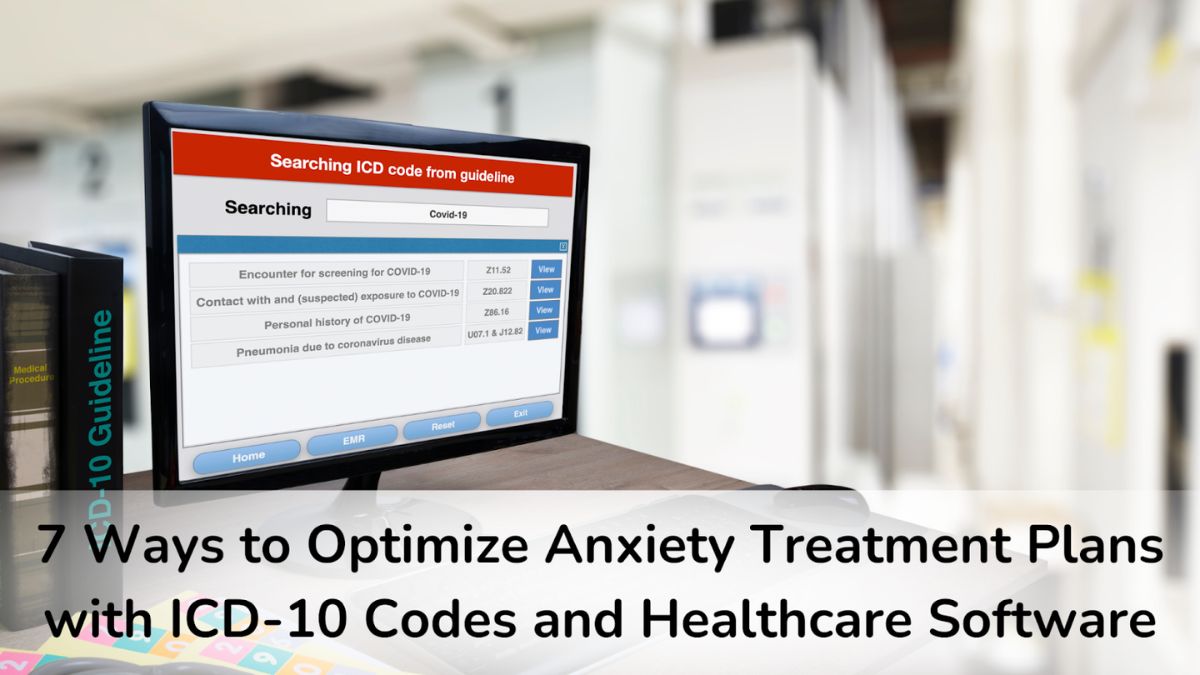HEALTH
7 Ways to Optimize Anxiety Treatment Plans with ICD-10 Codes and Healthcare Software

Why is managing anxiety disorders becoming increasingly challenging for healthcare providers? As the complexity of mental health care grows, so does the need for efficient, accurate, and personalized treatment approaches.
Mental illnesses are among the most common health conditions in the United States, with more than 1 in 5 US adults living with a mental illness. This statistic underscores the pressing need for tools that enhance diagnostic precision. ICD-10 codes and healthcare software offer powerful solutions for these challenges.
By using these tools, healthcare providers can enhance their diagnostic precision, streamline treatment planning, and improve overall patient care. This article explores how the integration of ICD-10 codes and advanced software can revolutionize anxiety treatment plans and lead to better outcomes for patients.
1. Leveraging ICD-10 Codes for Precise Diagnosis
ICD-10 codes provide a standardized system for classifying diseases and health conditions. For anxiety disorders, these codes offer a detailed breakdown of different types and manifestations. Some common ICD-10 codes for anxiety disorders include F41.0 for panic disorder without agoraphobia, F41.1 for generalized anxiety disorder, F40.10 for social anxiety disorder, and F42 for obsessive-compulsive disorder.
Using the correct ICD-10 code for anxiety disorders allows for more accurate diagnosis, tailored treatment plans, and improved communication between healthcare providers. It also enables better tracking of patient progress and enhanced data analysis for research purposes. By utilizing these codes effectively, healthcare professionals can ensure that each patient receives the most appropriate care for their specific condition.
2. Integrating ICD-10 Codes with Electronic Health Records (EHRs)
Modern healthcare software allows for the seamless integration of ICD-10 codes into electronic health records. This integration enables healthcare providers to quickly input and access diagnostic information, track changes in diagnosis over time, and generate comprehensive reports on patient progress.
Easily updating and reviewing this information ensures that treatment plans remain relevant and effective throughout the course of care. By incorporating ICD-10 codes into EHRs, healthcare providers can share standardized information across different departments and facilities.
This integration ensures continuity of care when patients transition between providers and facilitate more efficient referrals to specialists when necessary. The result is a more cohesive and collaborative approach to anxiety treatment, with all involved parties working from the same, up-to-date information.
3. Utilizing Data Analytics for Treatment Optimization
Healthcare software equipped with robust data analytics capabilities can help providers analyze treatment outcomes across different anxiety disorders. These tools can identify patterns in symptom presentation and progression, as well as recognize comorbidities and their impact on treatment efficacy. Leveraging this information allows healthcare professionals to make more informed decisions about treatment strategies and interventions.
Data analytics allows healthcare providers to tailor treatment plans based on patient-specific factors. By analyzing large datasets, providers can predict potential challenges in treatment and proactively address them. This approach enables the adjustment of interventions based on real-time data and patient feedback, resulting in more effective and personalized care for individuals with anxiety disorders.
4. Enhancing Medication Management with ICD-10 Codes and Software
Integrating ICD-10 codes with medication management software allows for more accurate medication selection based on specific anxiety diagnoses. This integration reduces the risk of adverse drug interactions and improves the monitoring of medication efficacy and side effects.
Linking prescription information directly to diagnostic codes helps ensure that patients receive the most appropriate medications for their specific anxiety disorder. Advanced healthcare software can automate prescription renewals based on ICD-10 codes and treatment plans.
These systems can generate alerts for potential drug interactions or contraindications, ensuring patient safety. Additionally, the facilitation of electronic prescribing improves efficiency and reduces errors in the medication management process, leading to better outcomes for patients with anxiety disorders.
5. Improving Patient Engagement through Technology
Leveraging healthcare software with patient-facing features can significantly enhance the treatment experience for individuals with anxiety disorders. Patient portals and mobile apps provide access to diagnostic and treatment information, enabling patients to actively participate in their care. These tools enable patients to track their symptoms and progress, fostering a sense of control and empowerment in managing their anxiety.
Integrating ICD-10 codes with teletherapy platforms enables continuity of care for patients unable to attend in-person sessions. This integration allows for real-time monitoring of patient progress and symptom changes, as well as the adjustment of treatment plans based on remote assessments. Teletherapy options have become increasingly important in ensuring that patients with anxiety disorders can access care regardless of geographical or mobility constraints.
6. Enhancing Billing and Insurance Claims Processing
Accurate use of ICD-10 codes in healthcare software can significantly improve the efficiency of billing and insurance claims processing. This integration reduces claim denials and delays in reimbursement, ensuring that healthcare providers can focus on patient care rather than administrative hurdles.
Improved accuracy in billing for anxiety-related services also fosters smoother communication with insurance providers, benefiting both patients and healthcare organizations. Integrated healthcare software helps providers maintain proper documentation for anxiety treatments. This integration ensures compliance with insurance requirements and regulations, reducing the risk of audits or payment disputes.
The ability to generate comprehensive reports for auditing purposes further streamlines administrative processes, allowing healthcare providers to allocate more time and resources to patient care.
7. Incorporating Artificial Intelligence for Predictive Analytics
The integration of artificial intelligence (AI) with ICD-10 codes and healthcare software opens up new possibilities for anxiety treatment. AI algorithms analyze vast amounts of patient data, including treatment histories, outcomes, and even genetic information, to predict the most effective interventions for specific anxiety subtypes.
This predictive analytics approach can help healthcare providers make more informed decisions about treatment strategies, potentially reducing the trial-and-error period often associated with finding the right anxiety management plan. AI can also identify subtle patterns that humans might miss, such as early warning signs of treatment resistance or the onset of comorbid conditions.
By leveraging AI in conjunction with ICD-10 codes, healthcare providers can stay ahead of potential complications and adjust treatment plans proactively, leading to improved patient outcomes and more efficient resource allocation.
|
Aspect |
Traditional Approach |
ICD-10 and Software Integrated Approach |
|
Diagnosis |
General categories |
Precise, specific coding |
|
Treatment Planning |
Often standardized |
Personalized based on data |
|
Patient Engagement |
Limited |
Enhanced through technology |
|
Care Coordination |
Can be fragmented |
Improved with shared EHRs |
|
Billing and Insurance |
Manual, error-prone |
Streamlined, more accurate |
|
Predictive Analytics |
Limited or non-existent |
AI-driven, data-based predictions |
Conclusion
Using ICD-10 codes and healthcare software can greatly improve anxiety treatment. These tools help make diagnoses more accurate and treatment plans more effective. They also make it easier for patients to be involved in their care. For healthcare providers, this means less paperwork and more time for patient care. Overall, this approach helps both doctors and patients, leading to better results in treating anxiety disorders.
Frequently Asked Questions
How often should ICD-10 codes be updated in a patient’s record?
ICD-10 codes should be updated whenever there’s a significant change in the patient’s condition or diagnosis. Regular reviews during follow-up appointments ensure the codes remain accurate and reflect the current treatment plan.
Can ICD-10 codes help with insurance pre-authorization for anxiety treatments?
Yes, accurate ICD-10 codes can streamline the pre-authorization process. They provide insurers with specific diagnostic information, potentially reducing delays and improving the chances of treatment approval for anxiety disorders.
How can small practices implement ICD-10 coding and healthcare software effectively?
Small practices can start with basic EHR systems that include ICD-10 coding features. Gradual implementation, staff training, and choosing user-friendly software can make the transition smoother and more cost-effective.
HEALTH
The Role of Medical Equipment Planners in Modern Healthcare Facilities

Medical equipment planners have become indispensable in the evolution of contemporary healthcare environments, effectively shaping how care is delivered through their deep understanding of clinical workflows and technological advancements. Partnering with a specialized medical equipment consultant ensures that healthcare facilities are efficiently equipped from conception to completion, supporting both daily operations and innovative healthcare delivery.
In today’s rapidly evolving healthcare landscape, organizations require professionals who can effectively bridge the technical requirements and patient needs. Medical equipment planners help avoid pitfalls that lead to delayed openings and costly retrofits. Their involvement from the earliest planning stages enables the seamless integration of increasingly complex healthcare technologies, guaranteeing that facilities are ready to meet future demands while staying within budget constraints.
Introduction
Modern healthcare facilities require a sophisticated approach to ensure that all spaces promote superior care, safety, and adaptability. Medical equipment planners bring a specialized skill set that covers the clinical, technical, and logistical elements needed to translate healthcare visions into functional spaces. Their forethought in procurement, placement, and lifecycle management means that every detail aligns with regulatory standards and clinical best practices, empowering healthcare leaders to succeed in a landscape marked by swift technological progress.
Bridging Clinical and Architectural Needs
A well-designed clinical space is the result of a synergetic process involving architects, engineers, and planners. Medical equipment planners stand at this intersection, ensuring that the layout, utilities, and workflow patterns support medical staff and optimize patient experiences. By collaborating from concept to construction, they anticipate where dedicated infrastructure—such as reinforced floors for imaging equipment or specialized electrical services for surgical suites—is essential.
This role is as much about shaping the healthcare environment as it is about problem-solving. Early engagement helps reveal obstacles, such as inadequate electrical capacity or suboptimal room sizing—challenges that are easier and less expensive to resolve before a facility’s physical footprint is finalized. As a result, healthcare spaces not only adhere to essential industry codes but also position care teams for maximum efficiency and responsiveness.
Integrating Advanced Technologies
The influx of digital health solutions and new medical devices puts planners in a critical position. They stay ahead of trends by collaborating with clinicians, technology vendors, and industry leaders to discern emerging needs and opportunities. Whether planning for telemedicine equipment, robotic surgical tools, or next-generation imaging technology, medical equipment planners research and recommend solutions that suit both present and anticipated future demands.
Staying Proactive in a Rapidly Changing Landscape
Planners must also navigate the intersection of cybersecurity, interoperability, and infrastructure readiness. This commitment to ongoing education and collaboration is why top healthcare systems prioritize the expertise of a seasoned planner. For additional insights into how technology is reshaping hospital care and planning, resources like Healthcare IT News offer timely and in-depth coverage of advancements and best practices.
Cost Efficiency and Patient Outcomes
Financial stewardship is at the heart of healthcare planning. A practical medical equipment planner reduces costs by eliminating unnecessary redundancies and by ensuring that equipment investments align with long-term needs. By creating flexible, future-forward spaces, they minimize expensive rework and help leadership seize opportunities for innovation without disruption. This not only saves money but also secures superior clinical outcomes through more streamlined workflows and improved patient safety.
Building Stronger Business Cases
Medical equipment planners assist administrators in justifying large capital expenditures. Their evidence-driven recommendations, rooted in clinical discussions and technology roadmaps, provide decision-makers with confidence that every equipment purchase supports both organizational goals and broader health system priorities. This strategic approach is reflected in policy discussions and analyses by well-respected healthcare publications such as Modern Healthcare, where the financial implications of hospital expansions and modernization projects are frequently explored.
Future Trends in Medical Equipment Planning
Healthcare is moving toward an era characterized by intelligent hospitals, data-driven decision-making, and continuous monitoring technologies. Forward-thinking equipment planners are vital to achieving this future. They balance the need for spaces that function today with the adaptability to upgrade or replace systems as medical science progresses seamlessly. Sustainable design, “Internet of Things” (IoT) adoption, and environmentally sensitive equipment procurement are among the key trends shaping their approach.
Ultimately, their role is about more than just procuring the right equipment. It’s about anticipating tomorrow’s needs and helping healthcare leaders create healing environments that stand the test of time—spaces where new generations of patients will benefit from ever-advancing care capabilities.
Conclusion
Medical equipment planners are the cornerstone of successful healthcare facility design, bridging the gap between clinical workflows and built environments. Their early and ongoing involvement leads to robust, flexible, and patient-centered spaces—ensuring that healthcare providers can deliver the best possible care today and adapt to breakthroughs for years to come.
HEALTH
Best Meeting Space Providers in Chennai for Small & Large Teams

Chennai, a thriving commercial and IT hub, has seen a significant rise in demand for professional meeting spaces accommodating teams of all sizes. Whether it’s a small startup hosting a client pitch or a multinational company organizing a large strategic workshop, finding reliable, well-equipped, and accessible meeting rooms is critical for seamless business operations. In 2025, the meeting space market in Chennai has matured with numerous providers catering to the diverse needs of businesses, offering flexible, tech-enabled environments without long-term lease burdens.
Leveraging platforms like GoFloaters, businesses can easily discover, compare, and book meeting room Chennai in prime locations — ensuring optimal facilities and cost-effectiveness whether for 4-person brainstorming sessions or 20+ participant corporate meetings.
Leading Meeting Space Providers in Chennai
1. Awfis
Awfis is a dominant player in Chennai’s flexible workspace market, offering premium meeting rooms that vary from compact 4-seater cabins to larger 15+ seater conference halls. Their locations span Guindy, Nungambakkam, Teynampet, and Perungudi, ensuring strategic access to tech parks, IT corridors, and business districts.
- Facilities: High-speed internet, video conferencing, whiteboards, projectors, power backup
- Prices: Starting at ₹760/hr for 4-seater rooms in Guindy, scaling up to ₹4,000/hr for large conference halls
- Ideal For: Startups, SMEs, corporate teams requiring professional settings and support services
2. Workafella
Workafella combines style with functionality, serving Chennai’s corporate clientele with upscale meeting rooms primarily in Teynampet, Nungambakkam, and Perungudi. Known for their modern ambiance and technology integration, Workafella rooms cater well for client meetings, workshops, and training.
- Facilities: Video conferencing units, ergonomic furniture, catering services on demand
- Team Size: From small team cabins (4-8 seats) up to medium-scale conference rooms (15-30 seats)
- Use Cases: Corporate presentations, product launches, board meetings
3. The Executive Zone
Situated in premium business hubs like Anna Salai and Guindy, The Executive Zone offers high-end meeting rooms suited for larger teams and high-stakes client interactions. Their rooms typically feature top-tier AV setups and dedicated event support staff.
- Key Strengths: Privacy, prestige, advanced tech infrastructure
- Capacity: 8-25 seats and customizable layouts
- Suitable For: International companies, consulting firms, finance and legal meetings
4. Regus
Regus, a global leader, provides reliable and consistent meeting spaces across multiple Chennai locations, including Mount Road and Guindy. Offering flexible hourly rental models, Regus is preferred by multinational businesses that value corporate-grade facilities with global standards.
- Features: Full tech support, video calling facilities, and professional reception
- Room Sizes: Small to large, accommodating diverse business events
- Reputation: Trusted brand with flexible booking options
Table: Meeting Room Providers Comparison in Chennai
| Provider | Locations | Price Range (₹/hour) | Room Sizes | Amenities | Ideal For |
| Awfis | Guindy, Nungambakkam, Perungudi | ₹760–₹4,000 | 4–15+ seater | Video conferencing, Wi-Fi, whiteboard | Startups, SMEs, Conference |
| Workafella | Teynampet, Nungambakkam | ₹900–₹3,500 | 4–30 seater | AV tech, ergonomic furniture, catering | Corporate meetings, workshops |
| The Executive Zone | Anna Salai, Guindy | ₹1,200–₹4,500 | 8–25 seater | Advanced AV, privacy, event staff | Large teams, VIP sessions |
| Regus | Mount Road, Guindy | ₹800–₹3,800 | 4–20 seater | Tech support, video calling, reception | MNCs, consulting firms |
Booking Meeting Rooms – Advantages of Using GoFloaters
Finding the perfect meeting space in Chennai is now simpler than ever with GoFloaters—an efficient platform offering:
- Comprehensive listings: Access to multiple providers and room options filtered by location, size, amenities, and price
- Transparent pricing: No hidden costs, hourly and daily rates clearly outlined
- Flexible booking: Book rooms instantly or reserve for future dates with easy cancellation policies
- Verified Reviews: Insights from other businesses to make informed decisions
- Added Amenities: Options for catering, parking, and tech support all available on demand
GoFloaters is especially beneficial for companies that have variable meeting needs—scaling up or down without the commitment of fixed infrastructure.
Tips for Choosing Meeting Spaces for Small and Large Teams
- Match room size to team size: Avoid overcrowding or too large a space that feels impersonal
- Prioritize tech amenities: Ensure high-speed internet, projectors, screens, and conferencing tools are functional
- Consider location convenience: Pick central or well-connected areas to enhance client satisfaction and employee convenience
- Check ambience & services: Professional interiors and support services (like reception and catering) elevate the meeting experience
- Budget and flexibility: Leverage pay-as-you-use models to optimize costs and adapt to changing business needs
Conclusion
Chennai’s dynamic business ecosystem calls for versatile meeting room solutions that cater to both small agile teams and large corporate groups. Leading providers like Awfis, Workafella, The Executive Zone, and Regus offer best-in-class facilities across prime locations, balancing technology, accessibility, and professionalism.Utilizing platforms like GoFloaters revolutionizes the booking experience, providing comprehensive options at transparent rates, and empowering businesses to secure the best meeting space for any occasion—without long-term commitments.
Whether it’s a crucial board meeting, client pitch, training workshop, or a team brainstorming session, Chennai’s top meeting space providers ensure your success with comfort, convenience, and cost efficiency.
HEALTH
Antiox Green Tea: Redefining Wellness in the Modern Age

In today’s rapidly evolving world, wellness is no longer measured solely by calorie counts or gym memberships. The most influential health trends are those that combine science, sustainability, and self-care, shaping lifestyles that thrive while uplifting communities and the planet. One such emerging staple is antiox green tea, a beverage recognized for its ability to align everyday habits with meaningful health impact.
This article explores antiox green tea’s rise in popularity, its core benefits, and why it represents the new generation of wellness solutions redefining healthy living.
What Is Antiox Green Tea?
Antiox green tea is more than just a hot drink. It’s a specially crafted green tea blend rich in antioxidants — compounds that fight free radicals, reduce oxidative stress, and support overall wellness. While traditional green tea has been consumed for centuries in Asia, the antiox green tea trend focuses on amplifying its health potential through careful sourcing, advanced processing, and awareness of sustainability.
It represents a growing movement of products that prove health benefits and environmental responsibility are not mutually exclusive but mutually reinforcing.
A Wellness Philosophy Rooted in Purpose
At the heart of the antiox green tea movement is a commitment to purposeful living. This philosophy emphasizes:
-
Holistic Nutrition: Looking beyond taste to understand how antioxidants, catechins, and polyphenols promote cellular health.
-
Sustainable Sourcing: Supporting tea farms and cooperatives that prioritize fair trade and environmentally responsible cultivation.
-
Community Well-being: Educating consumers about wellness practices while reinvesting in local and global initiatives tied to health and sustainability.
This approach reflects the growing recognition that modern wellness cannot exist in isolation — it is embedded in ecosystems, supply chains, and communities that must also thrive.
Bridging Personal Health with Global Impact
What makes antiox green tea especially noteworthy is its ability to merge individual health gains with tangible community and environmental benefits. Examples of this approach include:
-
Conscious Packaging: Using biodegradable or recyclable materials to minimize ecological footprint.
-
Local Empowerment: Partnering with smallholder farmers to ensure fair pay and skill development.
-
Innovation for Wellness: Leveraging advanced processing methods to preserve nutrient integrity and flavor profiles.
By embedding these values into production and consumption, antiox green tea illustrates how lifestyle choices can create a virtuous cycle of wellness—where healthy individuals support healthier communities, which in turn sustain the environment.
Influence in the Digital Age
As a rising wellness trend, antiox green tea benefits from the global reach of digital platforms and media influence. Social networking, wellness blogs, and influencer marketing amplify conversations around responsible consumption and holistic health.
This savvy use of digital media enables antiox green tea brands and advocates to:
-
Reach broader audiences with messages of sustainability and well-being.
-
Engage with younger generations who value transparency, authenticity, and environmental responsibility.
-
Inspire other products to integrate purpose-driven approaches into their sourcing and marketing strategies.
A Model for the Next Generation of Wellness Consumers
The rise of antiox green tea reflects broader shifts in wellness expectations, particularly among Millennials and Gen Z. Younger consumers increasingly look to products that embody:
-
Authenticity: Clear labeling, transparent sourcing, and honest health claims.
-
Diversity and inclusion: Supporting diverse growers and promoting accessibility across markets.
-
Global awareness: Recognition of interconnected challenges, from climate change to public health disparities.
By championing these principles, antiox green tea has positioned itself as both a trailblazer and a standard-bearer, guiding other health beverages toward a future where personal wellness naturally aligns with social impact.
Core Health Benefits of Antiox Green Tea
Antioxidant-rich green tea offers a wide range of potential health benefits backed by modern research:
-
Boosted Metabolism: Catechins may support fat oxidation and weight management when combined with a balanced diet.
-
Enhanced Immunity: Polyphenols and flavonoids support immune response and reduce inflammation.
-
Heart Health: Regular consumption may contribute to healthier cholesterol levels and improved circulation.
-
Mental Clarity: L-theanine, naturally present in green tea, promotes calm alertness and focus.
-
Anti-Aging Properties: Antioxidants help neutralize free radicals, which are linked to premature aging.
These benefits make antiox green tea not only a beverage but a cornerstone of modern wellness routines.
Challenges and Opportunities
Like any emerging health trend, antiox green tea faces challenges:
-
Balancing affordability with quality: Ensuring high antioxidant content without pricing out mainstream consumers.
-
Convincing skeptics: Demonstrating that benefits are evidence-based rather than hype-driven.
-
Navigating global supply chains: Maintaining ethical sourcing amid rising demand.
Yet these challenges also present opportunities for innovation. Transparent lab testing, direct trade partnerships, and creative packaging solutions allow antiox green tea brands to stand out while delivering real impact.
How to Integrate Antiox Green Tea Into Daily Life
Much like developing a healthy habit, incorporating antiox green tea into your daily routine can yield long-term benefits:
-
Morning Boost: Swap your regular coffee for a cup of antiox green tea to start your day with steady energy.
-
Midday Reset: Use it as a mindful break at work to refocus and recharge.
-
Pre-Workout Hydration: Its natural compounds may support endurance and recovery.
-
Evening Wind-down: Choose a decaffeinated version for antioxidant benefits without disrupting sleep.
This routine transforms the beverage from an occasional indulgence into a cornerstone of your wellness lifestyle.
Looking Ahead
As antiox green tea continues to expand its influence, its trajectory signals a new paradigm in health and wellness—one that values resilience, sustainability, and community alongside individual performance and vitality. In a world where consumers increasingly demand accountability and purpose, products like antiox green tea are well-positioned to set the standard.
With ongoing innovation in functional beverages, expect to see antiox green tea integrated into ready-to-drink formats, supplements, and even culinary creations—bringing its antioxidant benefits to new audiences worldwide.
Conclusion: A New Standard in Wellness
Antiox green tea endures and grows because it speaks to a universal human need: the desire for balance, health, and purpose in everyday living. It transcends fads by combining centuries-old tradition with cutting-edge sustainability and nutrition science.
In embracing antiox green tea, consumers not only choose a beverage but participate in a movement that elevates individual well-being while contributing to a healthier planet. In a world marked by rapid change and uncertainty, this antioxidant-rich tea remains a steady beacon—guiding countless people toward energy, clarity, and longevity.
-

 HEALTH2 years ago
HEALTH2 years agoIntegrating Semaglutide into Your Weight Loss Plan: A Practical Guide
-

 HOME IMPROVEMENT2 years ago
HOME IMPROVEMENT2 years agoHow to Choose the Perfect Neutral Area Rug for Every Room
-

 LAW1 year ago
LAW1 year agoTeenage Drivers and Car Accidents in California: Risks and Parental Liability
-

 CONSTRUCTION1 year ago
CONSTRUCTION1 year agoConstruction Site Safety Regulations in New York and Your Rights as a Worker
-

 LAW1 year ago
LAW1 year agoPost-Divorce Considerations in California: Modifications and Long-Term Planning
-

 HOME2 years ago
HOME2 years agoSandra Orlow: The Teen Model Who Captivated the Internet
-

 FINANCE1 year ago
FINANCE1 year agoDigital Asset Management in Florida Estate Planning
-

 FASHION2 years ago
FASHION2 years ago7 Celebrity-Inspired Elegant Summer Dresses For 2024
